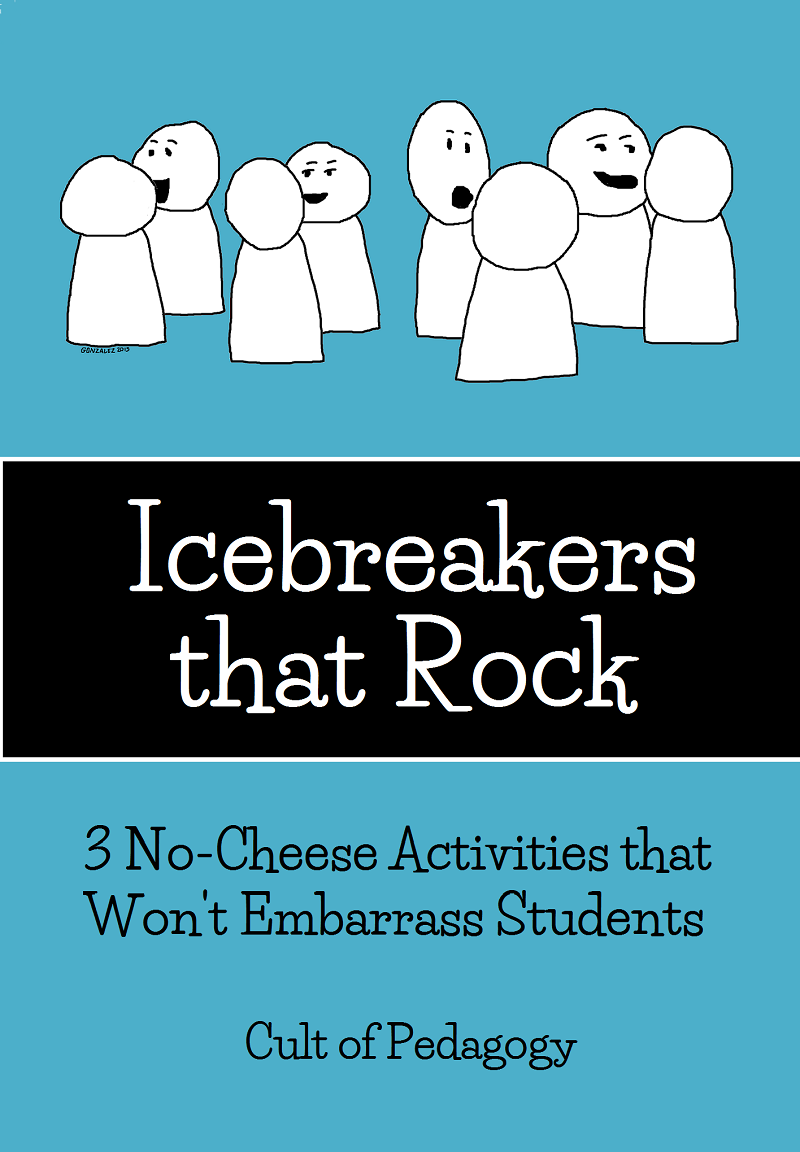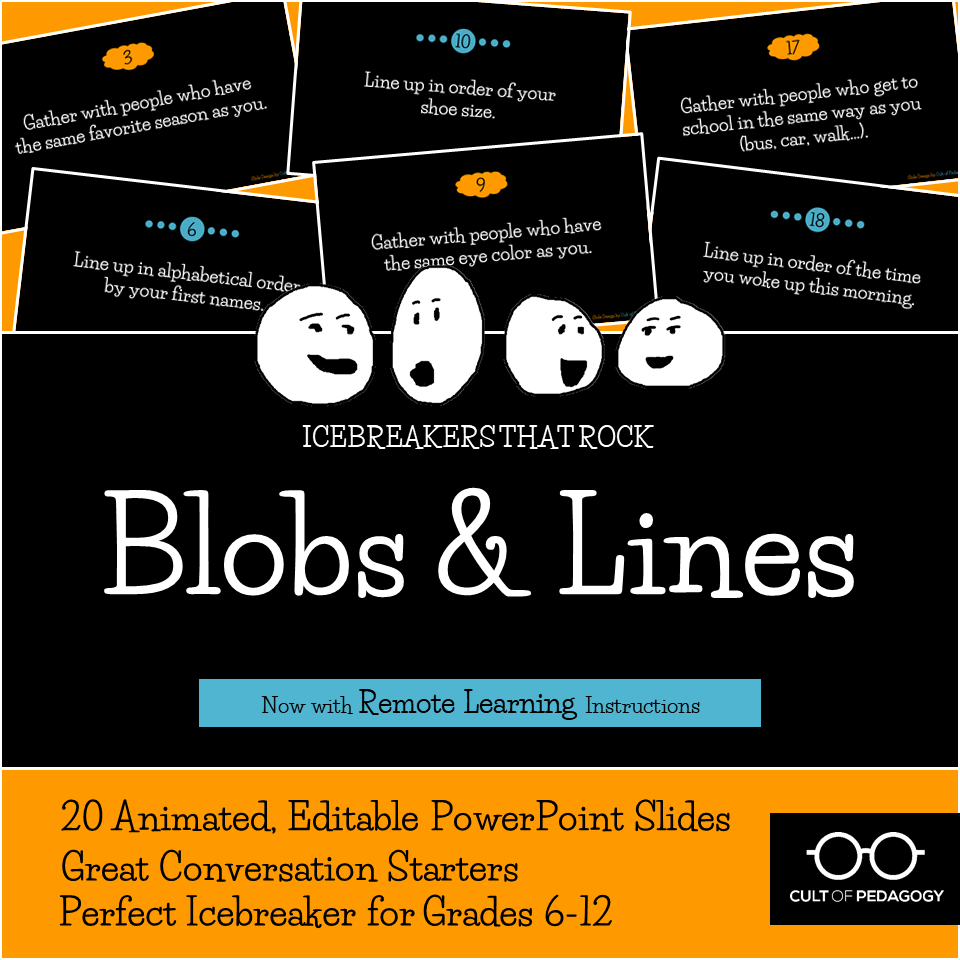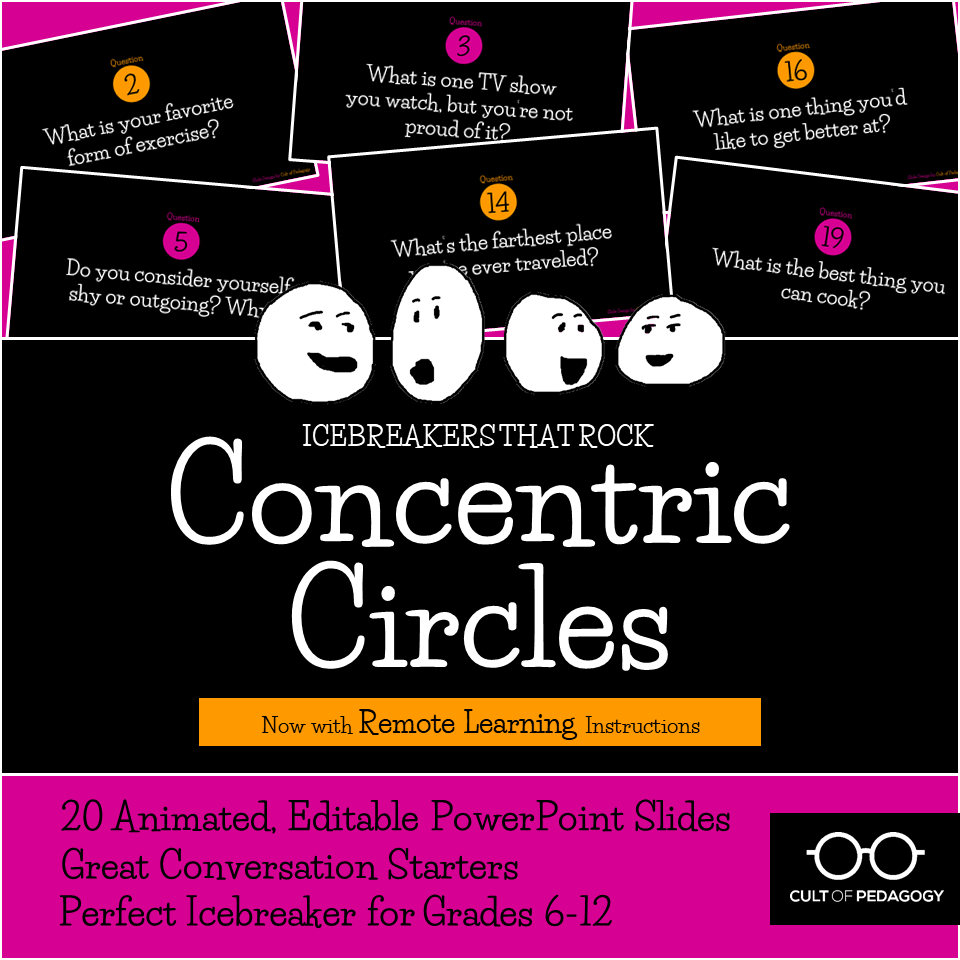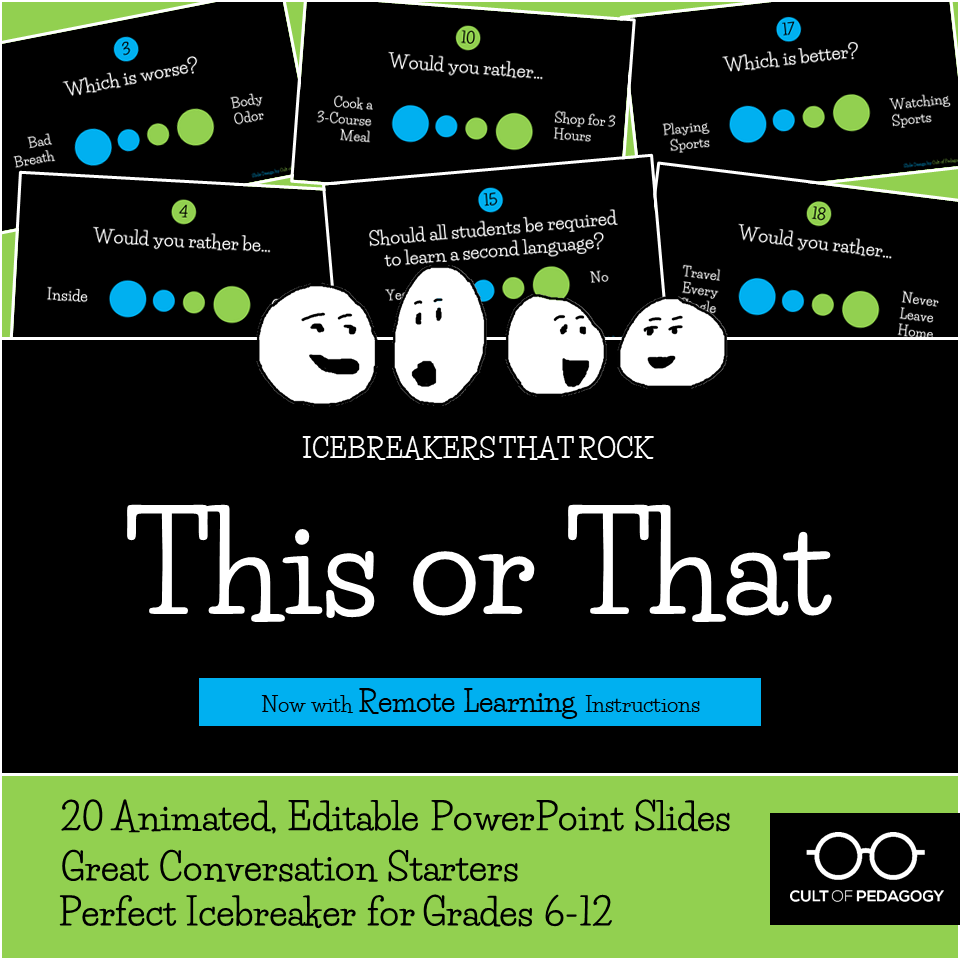Icebreakers that Rock

SEE THE END OF THIS POST FOR INSTRUCTIONS ON DOING THESE ICEBREAKERS REMOTELY.
We’re coming up fast on the beginning of another school year. That means a new batch of students to get to know, students who need to be made comfortable in your classroom, and who need to get to know each other. It’s essential to start building relationships with your students right from the start.
And how to accomplish this? Icebreakers.
The Trouble with Most Icebreakers
I planned to create a nice big post with dozens of icebreaker ideas you could choose from. I would scour the Internet for the very best activities and games and store links to them here for your reference. The problem is that so many of the ones I’ve found are problematic for one of these reasons:
- They require students to take massive social risks with people they barely know. So many of the icebreakers I found asked students to publicly share some kind of personal information. For the icebreaker to actually work, students would need to share something interesting and different about themselves, something that makes them stand out. But to most kids—especially once they get into the middle and high school range—being different is the worst thing you can be. So what many students ultimately do is share something safe and boring, something like “I like soccer,” just so the game moves on to the next person. The result? No one really gets to know anyone.
- They don’t actually facilitate familiarity. Too many icebreakers consist of questions like this: “If you could be an animal, what animal would you be?” Unless you have a ridiculously deep and creative kid who is going to say something like, “I would be a mongoose, because a mongoose can kill venomous snakes, and I have a way of standing up to bullies even though I’m small,” you’re mostly going to get a lot of cat-cat-dog-dog-fish, et cetera. Unless of course you force creativity on them by insisting that no animals can be repeated, thereby making the poor kids try to come up with some stinking animal that somehow represents the least embarrassing aspect of their personality and isn’t a repeat of anyone else’s animal. I’m annoyed just writing about it, and I repeat: No one really gets to know anyone.
- They are cheesy. The icebreaker I have been subjected to most often is the “Name Game,” where you have to add a word to your name that starts with the same letter as your name AND tells something about you. Guh. Because my name starts with a J, I have always hated this game, because jazzy doesn’t have anything to do with me. Neither does jelly or jalopy or joyful. Once you’ve chosen your word, people have to go around the circle repeating the newly enhanced names of the classmates who came before them in line. This means having to listen to Jammin’ Jenn over and over, my eyes rolling, my grimace deepening. One year I just rebelled and picked a different letter; I think I called myself something like Indoor Jenn, due to my aversion to the outdoors. That felt better.
So I have scrapped my plan to curate good icebreakers from the Internet. Instead, I’m going to share my three favorites with you.
Three Icebreakers that Don’t Suck
In my own classrooms, with middle school, high school, and college students, I have played all three of these games with great success. What I like about all of them is that they get students talking, but require very little social risk. Each activity supplies students with real topics to talk about, topics that actually help students get to know each other, without forcing anyone to reveal anything too personal.
Each of these will likely sound familiar to you, although the names may not be exactly what you’ve known them as. I should add that I take no credit for inventing these games. I have no idea where I picked them up, but they are not original to me.
Blobs and Lines
In this icebreaker, students are prompted to either line up in some particular order (by birthday, for example) or gather in “blobs” based on something they have in common (similar shoes, for example). What’s great about this game is that it helps students quickly discover things they have in common. It’s also ridiculously easy: Students don’t have to come up with anything clever, and they can respond to every question without thinking too hard about it. This game keeps students moving and talking, and it builds a sense of belonging and community in your classroom.
Here are some sample prompts you can use for this game:
- Line up in alphabetical order by your first names.
- Line up in alphabetical order by your last names.
- Gather with people who have the same favorite video game as you.
- Line up in order of your birthdays, from January 1 through December 31.
- Line up in order of how many languages you speak.
- Gather with people who have the same favorite season as you.
Concentric Circles
This icebreaker has students arrange themselves in an inside circle and an outside circle, the inside facing out, forming pairs. Pairs discuss their answers to a getting-to-know-you question, then rotate for the next question, forming a new partnership. This game gives students the chance to have lots of one-on-one conversations with many of their classmates and helps them quickly feel more at home in your class.
The possibilities for questions in this kind of configuration are endless; be sure to use more open-ended questions that can get students talking, rather than those that simply ask for a yes or no answer. Here are some sample questions:
- Do you play any sports? If so, which ones?
- Do you consider yourself shy or outgoing? Why?
- What was the last movie you saw? Did you like it?
- Describe your perfect dinner.
- What is one thing you’re good at?
This or That
This icebreaker has students informally debate on light topics such as “Which animal makes a better pet…dog or cat?” Students have to choose a position, then physically move to the side of the room that most closely represents their opinion—one side means dogs, the other side means cats—and then talk about why they chose that spot. This game has always been a HUGE hit with any group I’ve ever taught: It builds student confidence with talking in front of their peers, it helps students quickly find kindred spirits, and it’s also just a lot of fun.
Sample questions for This or That:
- Would you rather live in the country or the city?
- Would you rather be indoors or outdoors?
- Which is better: Playing sports or watching sports?
- Would you rather travel every single day or never leave home?
Want These Games Ready-Made?
I have created beautiful, animated PowerPoint versions of each of these games, plus a bundle of all three. The files work on Windows, Mac, and Google Slides, and they are all editable, so you can add or change questions anytime you like.



What About Remote Learning?
These instructions outline how to play these games using PowerPoint or Google Slides for the questions and Zoom for videoconferencing. If you are using different software you can probably still adapt the process to your own platforms.
IF YOU ARE TEACHING IN PERSON, students will likely have to be socially distanced and can’t play these games as they would pre-COVID. My recommendation is that you create an Avatar Classroom on a Google Slide, then have students “move” around with their Avatars, but still talk from their desks. You could also just follow the remote instructions above and have everyone plugged into devices so they could talk in breakout rooms, etc. It may seem to defeat the purpose of being in school together, but students can still look across the room at each other while participating — I think it would be pretty fun.